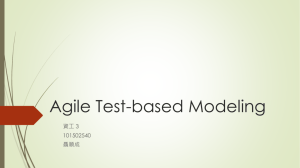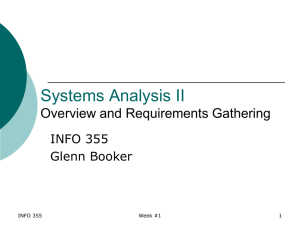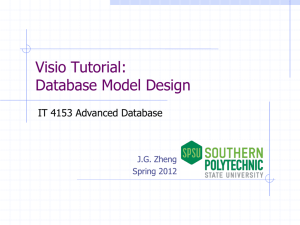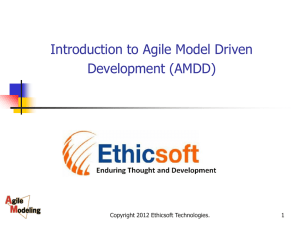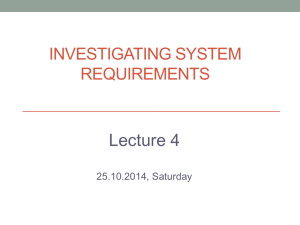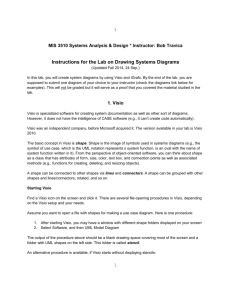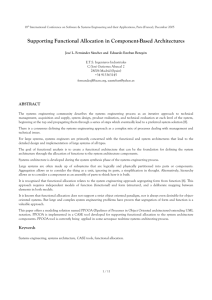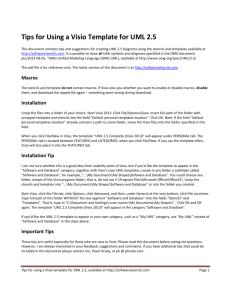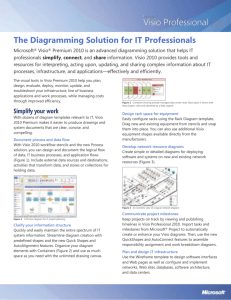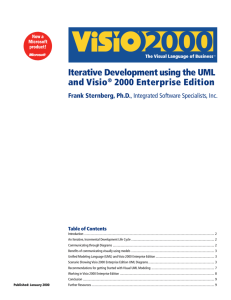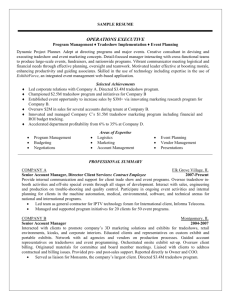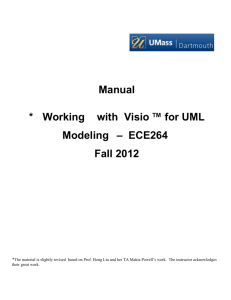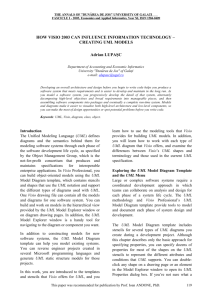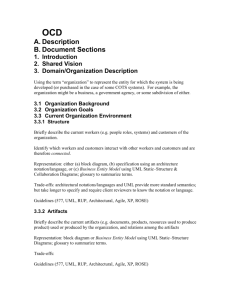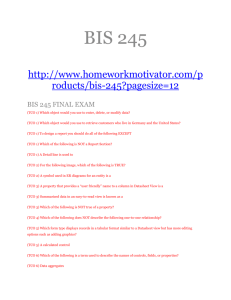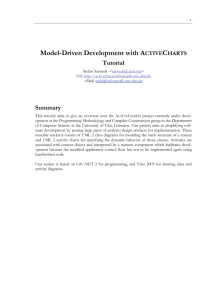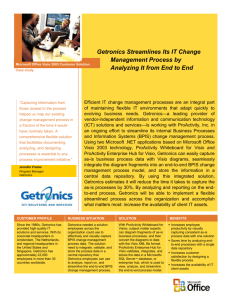Software Development, System Analysis and Design
advertisement
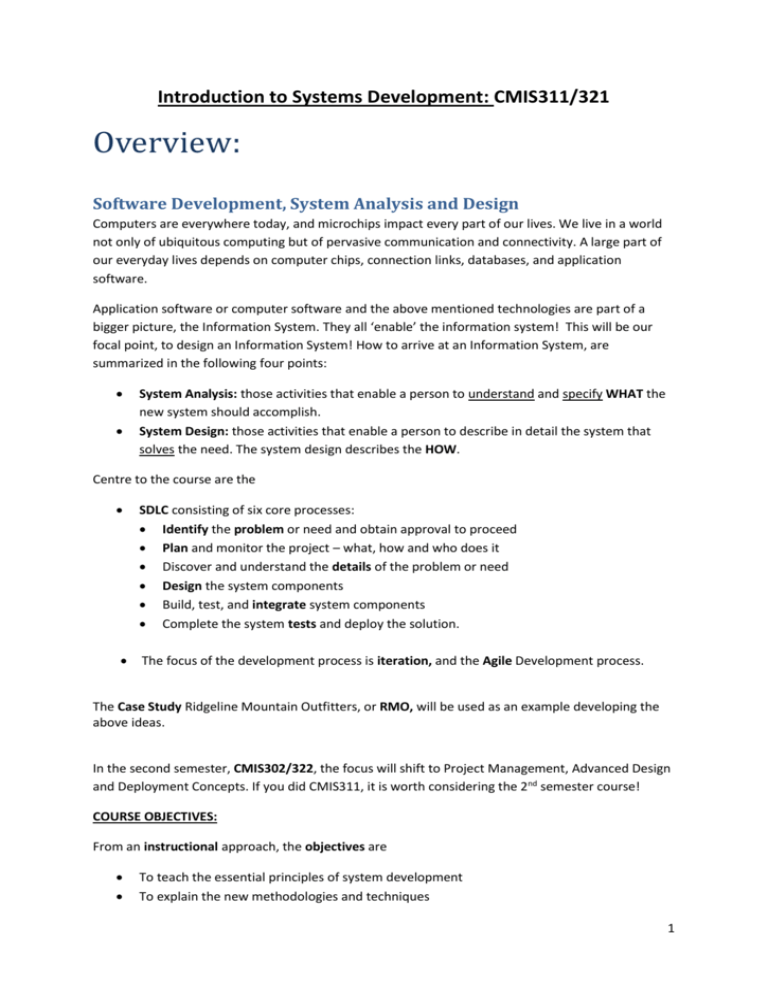
Introduction to Systems Development: CMIS311/321 Overview: Software Development, System Analysis and Design Computers are everywhere today, and microchips impact every part of our lives. We live in a world not only of ubiquitous computing but of pervasive communication and connectivity. A large part of our everyday lives depends on computer chips, connection links, databases, and application software. Application software or computer software and the above mentioned technologies are part of a bigger picture, the Information System. They all ‘enable’ the information system! This will be our focal point, to design an Information System! How to arrive at an Information System, are summarized in the following four points: System Analysis: those activities that enable a person to understand and specify WHAT the new system should accomplish. System Design: those activities that enable a person to describe in detail the system that solves the need. The system design describes the HOW. Centre to the course are the SDLC consisting of six core processes: Identify the problem or need and obtain approval to proceed Plan and monitor the project – what, how and who does it Discover and understand the details of the problem or need Design the system components Build, test, and integrate system components Complete the system tests and deploy the solution. The focus of the development process is iteration, and the Agile Development process. The Case Study Ridgeline Mountain Outfitters, or RMO, will be used as an example developing the above ideas. In the second semester, CMIS302/322, the focus will shift to Project Management, Advanced Design and Deployment Concepts. If you did CMIS311, it is worth considering the 2nd semester course! COURSE OBJECTIVES: From an instructional approach, the objectives are To teach the essential principles of system development To explain the new methodologies and techniques 1 To use a tool to model/document the above specifications, i.e. requirements. Define a solution To encourage team work to build a solution The course will consist of the following topics: Introducing system development Identify analysis tasks Designing a system Important is mastering the following skills: Soft skills: Interviewing and talking to users. Hard skills: technical and detail the specifications and designing solutions, usually consisting of creating models that capture specifications or define solutions STUDY METHOD/APPROACH: We will run the course in true OBE fashion, meaning ‘student-centred learning’. The old saying is still true: You read and you forget, you see and you remember, you DO and you UNDERSTAND. The implication is that we will expect from you to work most of the times on your own, realizing your own potential. Therefore: Attend all your lectures and at the same time work through the study material as indicated in the ‘Weekly Plan’ schedule below. The outcomes spell out what is expected from you; always assess yourself in terms of these outcomes. Theory: Make sure you understand the key terms after each chapter. Do the Review Questions. Problems and exercises will be assigned as Homework. These will be done in groups, consisting of two people. It is your responsibility to inform me who make-up your team of two people! Otherwise, it will look as if you were copying the work, and it will nullify your attempt. Practical/Documentation: This will be assigned as we progress through the course work, using UML from MS Visio. NOTE FROM THE LECTURER: I hope that you will find the module interesting and that it will exceed your expectations. It will be a bumpy ride at times, but you will enjoy it: your attitude will set your latitude! Good luck! TEXTBOOK: Satzinger, Jackson, Burd, Introduction to System Analysis and Design: An Agile, Iterative Approach, 6th edition, Course Technology, 2012 RECOMMENDED BOOKS: Introduction to Object-Oriented Analysis and Design, with UML and UP, by SR Schach(ISBN 0071215107) 2 UML 2 and the Unified Process, by J Arlow & I Neustadt, 2nd Edition (ISBN 0321321278) Use Case Driven Object Modeling with UML Theory and Practise, by D Rosenberg and M Stephens, 2007 (ISBN 9781590597743) Object-Oriented Analysis and Design with UML, by RV Stumpf and LC Teague, 2005 (ISBN 131434063) Understanding Object-Oriented Programming with Java, by T Budd ASSESSMENTS: Test 1: System Requirements Test 2: Use Cases Test 3: Domain Modeling Test 4: Revision on tests 1-3 and o Use case descriptions o Activity diagrams o System sequence diagram o State Machine Diagram Test 5: Design activities Test 6: User and System Interfaces You can assume that the tests will have a theory as well as a STRONG practical component. Test dates as well as the outcomes, will be decided in class. If you are absent for any of these tests, satisfactorily and relevant documentation must be submitted to the lecturer within a week of the test date. EXAMINATION: The examination contributes 60% to the Final Mark of the course. A learner will NOT BE ADMITTED to write the final examination unless a course mark (DP) of 40% has been obtained. The DP mark is made up of the above mentioned tests. The exam paper will last for at least 5 hours, with quite a focus on UML. CONSULTATION TIMES: Make an effort to make an appointment during class, or use e-mail, but it will be discussed during lecture time. ATTENDANCE: It is compulsory for students to attend classes. 3 RULES OF THE LAB: Read the notices at the entrance of the laboratory. This is in the hand of the lab management, and there is no way that I can influence them, besides, you are senior students and must set an example to the juniors! DUE DATES OF ASSIGNMENTS: Ensure that all practicals, assignments are submitted on time, accordance with due dates. Should you not submit by the required date, a mark of ZERO will be awarded. SPECIFIC OUTCOMES, ASSESSMNET CRITERIA and ASSESSMENT INSTRUMENTS: All outcomes are explained in the beginning of each chapter! I will not repeat them here, and the way you respond to the outcomes, are actually the criteria! The instruments can be or a combination of: Multiple Choice Questions Paragraph to Page/s length answers Applying MS Visio WEEK BY WEEK PLAN: Week 1, 2 3, 4 5, 6 7, 8 9, 10 11, 12 13, 14 Topics An Overview of Systems Analysis and Design Investigating Systems Requirements Use Cases Domain Modeling Extending the Requirements Models Essentials of Design and the Design Activities Designing the User and System Interfaces Chapter Readings Chapter 1 Chapter 2 Chapter 3 Chapter 4 Chapter 5 Chapter 6 Chapter 7 In true architectural fashion, one can say, ‘you are the architect of your own future’! ******************** Best of Luck! Enjoy!!********************** 4 Chapter 1: Class Exercise Outcomes: To be introduced to a small project, that sets the trend for the rest of the course To create a small information system (app), that will be added to the SCM To demonstrates one iteration of the small project, assuming there are more To explore all six core processes of SDLC To realize that projects are planned and monitored: to complete iteration in six days Introduction: Ridgeline Mountain Outfitters (RMO) Large Retail Company outdoor and sporting clothing and accessories Skiing, mountain biking, water sports Hiking, camping, mountain climbing Rocky Mountain and Western States Started mail order and phone order Added retail stores Added extensive E-business component 5 RMO Tradeshow System: Problem-- purchasing agents attend apparel and fabric trade shows around the world to order new products from suppliers Need– information system (app) to collect and track information about suppliers and new products while at tradeshows Tradeshow Project– is proposed Supplier information subsystem Product information subsystem Pre-Project Activities Identify the problem and document the objective of the system (core process 1) 6 Preliminary investigation System Vision Document Obtain approval to commence the project (core process 1) Meet with key stakeholders, including executive management Decision reached, approve plan and budget Iterative and Agile Systems Development Lifecycle (SDLC): Question 1: What is a WBS? Question 2: Map the Work Sequence draft to MS Project 7 Question 3: What is a Use Case? 8 Question 4 a): List the Use cases for the Tradeshow System: Use Case Description b) Map the Use case above to a Use case diagram of MS Visio c) What is an Object class? d) Identify the Object classes Object Class Attributes e) Draw a class diagram using MS Visio. Question 5 a): What is Workflow Diagram? b) Draw an Activity Diagram from MS Visio Question 6: Draw a generalized workflow of testing tasks. 9
